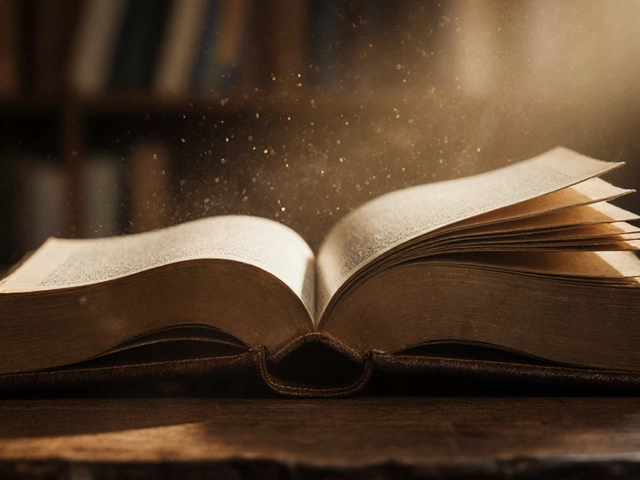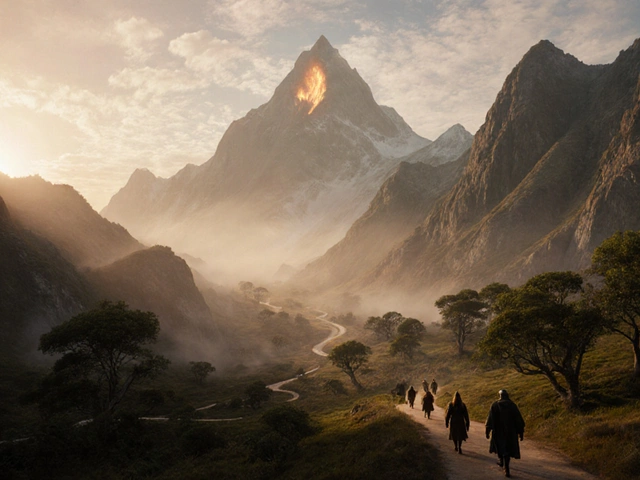Picture a story where everything feels just a bit off. Not in a haunted-house, straightforward-horror kind of way, but something tangled up with laughter, repulsion, and surprise. That “off-ness”—where beauty crashes headlong into the bizarre—is the heart of grotesque fiction. It’s a style that doesn’t just want to scare you; it wants to scramble your comfort zone and daringly blur the line between what attracts us and what creeps us out. This stuff lives in those weird, shadowy spaces—where things can be sad and funny at once, or beautiful and nasty all in the same breath. Think of Kafka’s “The Metamorphosis”—that iconic image of Kafka’s poor Gregor Samsa, waking up as a giant bug. Kind of hilarious, but also horribly sad and, honestly, pretty gross. That’s the grotesque at work, making you feel a mix of everything all at once.
How Did Grotesque Fiction Crawl Into Our Stories?
The roots of grotesque fiction dig deep. The term itself comes from the Italian "grottesca," which described odd, twisting figures and creatures found in the ruins of ancient Rome—a real mishmash of humans, animals, and plants all mashed together in weird new forms. Artists started using the word for their strange art, and soon writers picked it up for their equally strange tales. Fast-forward to the 18th and 19th centuries: the Gothic novel exploded. Stories like Mary Shelley’s "Frankenstein" and Edgar Allan Poe’s short tales were full of half-human monsters and decaying castles, all stuffed with the uncomfortable and weird. The grotesque was everywhere, not just as pure horror but in moments that made you giggle uncomfortably one second and squirm the next.
By the 20th century, the grotesque had become a playground for some of literature’s wildest creators. Flannery O’Connor, for example, bent Southern life into twisted, funny, and sometimes disturbing shapes in her stories. Franz Kafka took bland European offices and filled them with insect-people and bureaucratic nightmares. Even comic books, like the earliest Batman stories, owed a lot to the grotesque by mixing crime with outlandish, monstrous villains. The genre keeps bubbling up today—think about the twisting nightmare worlds of Guillermo del Toro movies or even how "Stranger Things" lures us with both creepy monsters and awkward teen drama. The grotesque, by refusing to choose between horror, comedy, and tragedy, sticks around because regular horror just isn’t weird enough.
But why do people keep returning to grotesque fiction? It’s not just about gross-outs or shock—though there’s plenty of that. It’s about exposing hidden truths, those odd, uncomfortable bits of life most of us try not to notice. Reading grotesque fiction is like poking at a bruise: you can’t help but look, even if you’re squirming. Plenty of social critics argue that the best grotesque stories push us to rethink what’s “normal,” and they sneak important questions into the strangest packages. Next time someone calls a story "weird," there’s a good chance it’s reaching for something even deeper: the grotesque pulls us in precisely *because* it makes us uncomfortable.
The Recipe for Grotesque: What Sets It Apart?
So what actually makes a story grotesque? It’s not just about monsters or gore. At its core, grotesque fiction is a mash-up: it loves mixing things that don’t normally go together—sorrow and humor, ugliness and beauty, the familiar and the utterly alien. One classic trick is a sense of “the abnormal in the normal.” You take something everyday and twist it just enough to make people raise an eyebrow (or gasp). Instead of creating villains who are simply evil, grotesque fiction makes them weirdly sympathetic or bizarrely funny. You might laugh even while you cringe, which is exactly the cocktail the genre serves up.
Physical transformation is a favorite. People morph into animals, bodies get stretched into absurd shapes—anything to blur the lines between what’s “human” and what isn’t. Emotional contradictions are big, too. In Flannery O’Connor’s stories, for example, characters act out of hatred and love all at once, or try to do good even though their motives are petty or strange. Dialogue often walks the line between smart and silly, adding another flavor to the story’s oddness.
The settings in grotesque fiction love decay and excess—swampy towns, dusty attics, run-down carnivals. The style isn’t about making the world pretty but finding fascination in things most people would avoid. If you spot a narrative that makes you laugh and squirm in the same sentence, you’re probably seeing the grotesque in action.
Some famous techniques or elements can help you spot grotesque fiction instantly:
- Bizarre or exaggerated characters (giant insects, deformed villains, eccentric lost souls)
- Dark humor, often in the harshest situations
- Bodies that don’t act like bodies usually do (think: metamorphosis, disease, unexplained transformations)
- Setting that highlights rot, decay, or stuff out of place
- Social satire—pointed critiques of “civilized” society hiding beneath the freakshow
- A sense of unease—the idea that the world is just a step away from complete chaos
This blend lets grotesque fiction punch through the usual boundaries of genre. It’s not afraid to make you laugh at things you know are ugly or shudder at things that feel too close to home. The genre marches to its own drum—delighting in the awkward, the uncomfortable, and the unsettling.
Standout Grotesque Fiction: Stories You Won’t Forget
If you’re looking for prime examples, start with the ones that keep popping up in classrooms and late-night reading lists alike. Franz Kafka’s grotesque fiction is often the first stop. "The Metamorphosis" remains unforgettable; an ordinary man wakes up as a bug, and suddenly, everything about life (jobs, family, self-worth) turns into a strange nightmare. But Kafka’s not alone. Flannery O’Connor’s "A Good Man Is Hard to Find" puts a regular Southern family on the road—then lets it all spiral off the rails in darkly comic, violent fashion. There’s laughter, but also real horror.
Mary Shelley’s "Frankenstein" is a classic: the monster, stitched from corpses, isn’t just scary—he’s profoundly sad and, sometimes, more relatable than his maker. Gabriel García Márquez’s magical realism dips into the grotesque just as easily, with events both gorgeous and strange, like rains that never end or ghosts wandering the house as casually as family.
Let’s talk modern stuff, too. China Miéville’s "Perdido Street Station" mixes sci-fi and grotesque—the wild cityscapes and impossible creatures have become must-reads for anyone who loves the weird. Clive Barker’s “Books of Blood” blend urban settings with grotesque horror, ripping everyday life wide open with monsters that don’t just scare, but puzzle or even amuse us. Even some comics, like Alan Moore’s “Swamp Thing” or Neil Gaiman’s “The Sandman,” snuggle darkly into grotesque territory—unafraid to let horror and beauty mingle in the same panel.
A lot of the genre’s high points are about turning the world upside-down—taking what we think is normal, and making us question it. You’re not just unsettled by the monsters; you can’t help but wonder if the real weirdness is hiding under your own skin.
Why Do We Love the Grotesque—and What’s Its Secret Power?
If you’re wondering why anyone would pick up a grotesque novel or film on purpose, remember this: people have always been a little obsessed with what freaks them out. There’s something addictive about the mix of emotions grotesque fiction provokes. One minute you’re horrified by a body morph or a social meltdown; the next, you’re giggling at a bit of slapstick or bitter irony. That emotional blend is what keeps people coming back.
Cultural critics will tell you: the grotesque thrives in societies caught between old rules and new chaos. It’s no accident that the peak times for grotesque fiction—think 19th-century Europe or the post-war US South—were all moments of massive social upheaval. When the world around us feels unpredictable, fiction that mirrors that chaos feels oddly comforting. In a way, grotesque fiction is like emotional exposure therapy. It lets us poke at the stuff that scares or grosses us out in a safe, artful setting.
Statistics on horror and horror-comedy sales back this up. In 2023, horror fiction sales in the US rose by 12%. Of the top ten bestsellers in the horror category, half contained strong grotesque or darkly comedic elements (“Mexican Gothic” by Silvia Moreno-Garcia and “The Southern Book Club’s Guide to Slaying Vampires” by Grady Hendrix, for example). The numbers show—this stuff sells.
| Year | US Horror Sales (millions) | % Grotesque Elements |
|---|---|---|
| 2021 | 23.2 | 38% |
| 2022 | 27.9 | 46% |
| 2023 | 31.2 | 51% |
There’s a sneaky benefit, too: grotesque fiction lets us see the world through new, weirder eyes, making it easier to spot hidden patterns or hypocrisies in real life. What’s more, psychologists sometimes use the term “catharsis” to explain how confronting the ugly, ridiculous, or revolting in fiction helps us manage our real-life fears. Rather than run from darkness, grotesque fiction invites us to laugh at it.
Tips for Reading—and Writing—Grotesque Fiction
If this is all making you want to dive into grotesque fiction, here are some ideas to make the most of it:
- When reading, highlight those moments where you feel two emotions at once—like pity and disgust, fear and laughter. That’s where the magic happens.
- Don’t get hung up on solving every question. Grotesque stories love ambiguity; the weird parts aren’t supposed to be fully “explained.”
- Notice how the setting and characters get bent out of shape. Ask yourself what the ugliness or absurdity is trying to reveal about “real” life—often it’s a sharp hidden critique.
- Keep an eye out for dark humor. Some of the most disturbing scenes in grotesque fiction are also the funniest. Embrace the weirdness.
- If you want to write grotesque fiction, start with a familiar setting, then twist one thing far enough that it causes discomfort. Make your characters act for reasons that don’t quite add up, and don’t be afraid to lean into the bizarre.
- Let the contradictions breathe. Grotesque fiction works best when there’s room for laughter, sadness, and horror to mix.
- Read widely: move from Kafka to O’Connor to Miéville to manga like Junji Ito. The grotesque crosses borders and genres.
Grotesque fiction isn’t for everyone, but if you stick with it, you might find yourself looking at the world around you with fresh eyes. Even in the middle of the most ordinary day, something a little bit weird—and wonderful—might be lurking just around the corner.


